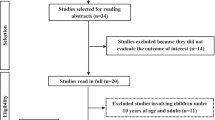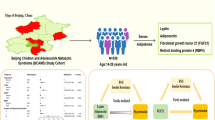Abstract
This study assessed the association of cardiometabolic risk factors with systemic inflammation, insulin resistance, and adypocytokines in a Hispanic adolescent subgroup. A clinic-based sample of 101 Puerto Rican adolescents, 48 of whom were overweight or obese based on body mass index percentiles for age and sex, was recruited during 2010. Data were collected through interviews, blood pressure and anthropometric measurements, and blood drawing. Overall prevalence of the metabolic syndrome was 16.8 % and increased to 37.5 % among overweight/obese youth. The overweight/obese group exhibited significantly (p < 0.05) higher values for abdominal obesity measures, systolic blood pressure, triglycerides, insulin resistance, C peptide, high-sensitivity C reactive protein, fibrinogen, leptin, and IL-6 and lower levels of high density lipoprotein cholesterol, adiponectin, and IGF-1. Total adiponectin significantly correlated with most cardiovascular risk factors independent of sex, Tanner stage, and adiposity. Altered cardiometabolic and adipocytokine profiles were present in this Hispanic subgroup, reinforcing the need to strengthen strategies addressing childhood obesity.
Similar content being viewed by others
References
Barlow SE, Expert Committee. Expert committee recommendations regarding the prevention, assessment, and treatment of child and adolescent overweight and obesity: summary report. Pediatrics. 2007;120(4):S164–92.
Masi S, Charakida M, Wang G, et al. Hope for the future: early recognition of increased cardiovascular risk in children and how to deal with it. Eur J Cardiovasc Prev Rehabil. 2009;16(2):S61–4.
Ogden CL, Carroll MD, Curtin LR, et al. Prevalence of obesity in body mass index among US children and adolescents, 1999–2010. JAMA. 2012;307(5):483–90.
Wiegand S, Maikowski U, Blankenstein O, et al. Type 2 diabetes and impaired glucose tolerance in European children and adolescents with obesity—a problem that is no longer restricted to minority groups. Eur J Endocrinol. 2004;151(2):199–206.
Li C, Ford ES, Zhao G, et al. Prevalence of pre-diabetes and its association with clustering of cardiometabolic risk factors and hyperinsulinemia among US adolescents: National Health and Nutrition Examination Survey 2005–2006. Diabetes Care. 2009;32:342–7.
Johnson WD, Kroon JM, Greenway FL, et al. Prevalence of risk factors for metabolic syndrome in adolescents: National Health and Nutrition Examination Survey (NHANES), 2001–2006. Arch Pediatr Adolesc Med. 2009;163:371–7.
Cruz ML, Weigensberg MJ, Huang TT, et al. The metabolic syndrome in overweight Hispanic youth and the role of insulin sensitivity. J Clin Endocrinol Metab. 2004;89:108–13.
Goran MI, Bergman RN, Avila Q, et al. Impaired glucose tolerance and reduced beta-cell function in overweight Latino children with a positive family history for type 2 diabetes. J Clin Endocrinol Metab. 2004;89:207–12.
Goran MI, Bergman RN, Cruz ML, et al. Insulin resistance and associated compensatory responses in African-American and Hispanic children. Diabetes Care. 2002;25:2184–90.
Weigensberg MJ, Ball GD, Shaibi GQ, et al. Decreased beta-cell function in overweight Latino children with impaired fasting glucose. Diabetes Care. 2005;28:2519–24.
Cruz M, García-Macedo R, García-Valerio Y, et al. Low adiponectin levels predict type 2 diabetes in Mexican children. Diabetes Care. 2004;27:1451–3.
Winer JC, Zern TL, Taksali SE, et al. Adiponectin in childhood and adolescent obesity and its association with inflammatory markers and components of the metabolic syndrome. J Clin Endocrinol Metab. 2006;91:4415–23.
Butte NF, Comuzzie AG, Cai G, et al. Genetic and environmental factors influencing fasting serum adiponectin in Hispanic children. J Clin Endocrinol Metab. 2005;90:4170–6.
Shaibi GQ, Cruz ML, Weigensberg MJ, et al. Adiponectin independently predicts metabolic syndrome in overweight Latino youth. J Clin Endocrinol Metab. 2007;92:1809–13.
Gilardini L, McTernan PG, Girola A, et al. Adiponectin is a candidate marker of metabolic syndrome in obese children and adolescents. Atherosclerosis. 2006;189:401–7.
Huang KC, Lin RC, Kormas N, et al. Plasma leptin is associated with insulin resistance independent of age, body mass index, fat mass, lipids, and pubertal development in nondiabetic adolescents. Int J Obes Relat Metab Disord. 2004;28:470–5.
Herder C, Schneitler S, Rathmann W, et al. Low-grade inflammation, obesity and insulin resistance in adolescents. J Clin Endocrinol Metab. 2007;92:4569–74.
Chu NF, Wang DJ, Shieh SM, et al. Plasma leptin concentrations and obesity in relation to insulin resistance syndrome components among school children in Taiwan—The Taipei Children Heart Study. Int J Obes. 2000;24:1265–71.
Centers for Disease Control and Prevention. State-specific incidence of diabetes among adults-participating states, 1995–1997 and 2005–2007. MMWR Morb Mortal Wkly Rep. 2008;57:1169–73.
National High Blood Pressure Education Program, Working Group on High Blood Pressure in Children and Adolescents. The fourth report on the diagnosis, evaluation, and treatment of high blood pressure in children and adolescents. Pediatrics. 2004;114:555–76.
Ford ES, Ajani UA, Mokdad AH. The metabolic syndrome and concentrations of C-reactive protein among US youth. Diabetes Care. 2005;28:878–81.
Fernández JR, Redden DT, Pietrobelli A, et al. Waist circumference percentiles in nationally representative samples of African-American, European-American, and Mexican-American children and adolescents. J Pediatr. 2004;145:439–44.
Keskin M, Kurtoglu S, Kendirci M, et al. Homeostasis model assessment is more reliable than the fasting glucose/insulin ratio and quantitative insulin sensitivity check index for assessing insulin resistance among obese children and adolescents. Pediatrics. 2005;115:e500–3.
Okosun IS, Seale JP, Boltri JM, et al. Trends and clustering of cardiometabolic risk factors in American adolescents from 1999 to 2008. J Adolesc Health. 2012;50:132–9.
Venegas HL, Pérez CM, Suárez EL, et al. Prevalence of obesity and its association with blood pressure, serum lipids, and selected lifestyles in a Puerto Rican population of adolescents 12–16 years of age. P R Health Sci J. 2003;22(2):137–43.
Stettler N, Elliot MR, Kallan MJ, et al. High prevalence of overweight among pediatric users of community health centers. Pediatrics. 2005;116(3):e381–8.
Centers for Disease Control and Prevention. Obesity prevalence among low-income, preschool-aged children—United States, 1998–2008. MMWR Morb Mortal Wkly Rep. 2009;58:769–73.
Rivera-Soto WT, Rodríguez-Figueroa L, Calderón G. Prevalence of childhood obesity in a representative sample of elementary school children in Puerto Rico by socio-demographic characteristics, 2008. P R Health Sci J. 2010;29:357–63.
Garza JR, Acosta-Pérez E, Prelip M, et al. Occurrence and correlates of overweight and obesity among island Puerto Rican youth. Ethn Dis. 2011;21(2):163–9.
Vangipurapu J, Stančáková A, Kuulasmaa T, et al. Association between liver insulin resistance and cardiovascular risk factors. J Intern Med. 2012;272:402–8.
Bao W, Srinivasan SR, Wattigney WA, et al. Persistence of multiple cardiovascular risk clustering related to syndrome X from childhood to young adulthood. The Bogalusa Heart Study. Arch Intern Med. 1994;154:1842–7.
Huang KC, Chen CL, Chuang LM, et al. Plasma adiponectin levels and blood pressures in nondiabetic adolescent females. J Clin Endocrinol Metab. 2003;88:4130–4.
Rubin DA, McMurray RG, Hackney AC, et al. Relationship between cardiovascular risk factors and adipokines in adolescents. Horm Res Paediatr. 2011;76:123–9.
Tschritter O, Fritsche A, Thamer C, et al. Plasma adiponectin concentrations predict insulin sensitivity of both glucose and lipid metabolism. Diabetes. 2003;52:239–43.
Kim ES, Park JH, Lee MK, et al. Associations between fatness, fitness, IGF and IMT among obese Korean male adolescents. Diabetes Metab J. 2011;35:610–8.
Sesti G, Sciacqua A, Cardellini M, et al. Plasma concentration of IGF-I is independently associated with insulin sensitivity in subjects with different degrees of glucose tolerance. Diabetes Care. 2005;28(1):120–5.
Theodorakis MJ, Carlson O, Muller DC, et al. Elevated plasma glucose-dependent insulinotropic polypeptide associates with hyperinsulinemia in impaired glucose tolerance. Diabetes Care. 2004;27:1692–8.
Beck-Nielsen H, Groop LC. Metabolic and genetic characterization of prediabetic states: sequence of events leading to non-insulin-dependent diabetes mellitus. J Clin Invest. 1994;94:1714–21.
Enoki S, Mitsukawa T, Takemura J, et al. Plasma islet amyloid polypeptide levels in obesity, impaired glucose tolerance and non-insulin-dependent diabetes mellitus. Diabetes Res Clin Pract. 1992;15:97–102.
Asakawa A, Inui A, Yuzuriha H, et al. Characterization of the effects of pancreatic polypeptide in the regulation of energy balance. Gastroenterology. 2003;124:1325–36.
Acknowledgments
This work was supported by grants from the National Institutes of Health (U54-RR026139 and U54-MD007587 to the Puerto Rico Clinical and Translational Research at the University of Puerto Rico; U54CA096297 and U54CA096300 to the UPR-MDACC Partnership for Excellence in Cancer Research Program; RO1-CA089266 to MHL; CA16672 to The University of Texas MD Anderson Cancer Center; Cancer Prevention Fellowship R25-TCA57730 to GVT), The MD Anderson Cancer Center Training Grant Program in Molecular Genetics (T32-CA009299 to EFM), and Susan G. Komen For the Cure, PROMISE grant (KG081048) to SCY and MHL. The authors are grateful to Dr. Angel Espinosa, Dr. Enrique Carrión, Dr. Olga Billoch-Joglar, Dr. Arelys Cabrera, Mrs. Hesmy Sánchez, Dr. Heidi Venegas and Dr. Winna Rivera for their support with conducting the study.
Author information
Authors and Affiliations
Corresponding author
Rights and permissions
About this article
Cite this article
Pérez, C.M., Ortiz, A.P., Fuentes-Mattei, E. et al. High Prevalence of Cardiometabolic Risk Factors in Hispanic Adolescents: Correlations with Adipocytokines and Markers of Inflammation. J Immigrant Minority Health 16, 865–873 (2014). https://doi.org/10.1007/s10903-013-9866-9
Published:
Issue Date:
DOI: https://doi.org/10.1007/s10903-013-9866-9




